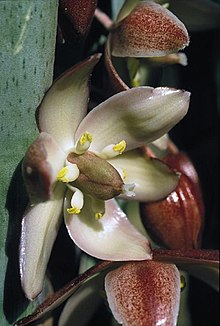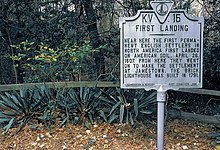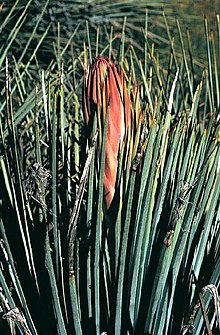Palm lilies
| Palm lilies | ||||||||||||
|---|---|---|---|---|---|---|---|---|---|---|---|---|

Yucca Section Chaenocarpa Series Rupicolae : Yucca queretaroensis in Mexico |
||||||||||||
| Systematics | ||||||||||||
|
||||||||||||
| Scientific name | ||||||||||||
| yucca | ||||||||||||
| L. |
The palm lilies or yuccas ( Yucca ) are a genus of plants from the asparagus family (Asparagaceae). It is a purely neotropical genus with a distribution focus in Central America .
description
Palm lilies are perennial, woody plants. Some species form a single trunk, other species branch out. The sessile, simple, parallel-veined, coarse, pointed, rigid leaves stand in rosettes . The leaf margins are smooth or, less often, serrated.
Depending on the species, plants that are more than ten years old can bloom. Many flowers stand together in paniculate inflorescences that look like a large lily of the valley . The hermaphroditic, radial symmetry , threefold flowers are bell-shaped or spherical. The six, often whitish bracts are of the same shape and free or fused at their base. There are six stamens with stamens that are about as wide as the anthers . Three carpels have become a top permanent ovary grown. The often thick, white to dark green style usually ends in a 1 to 2 mm large, usually three-lobed stigma, but sometimes it is head-shaped.
There are cap fruits or berries formed. Each fruit contains many black, sometimes gray, seeds.
Some species are frost hardy, so they can survive in the Central European climate.
ecology
Like the genus Ficus, yucca is a typical example of coevolution between insects and plants. All representatives of this genus are dependent on pollination by females of the yucca moths; in Ficus it is fig wasps (Agaonidae). Through the redesigned lower jaw button to pollen to Yucca transported blossoms and actively deposited there on the scars. At the same time, eggs are laid in the flowers, whose larvae then feed on the seeds. However, the consumption is low, so that sufficient seeds can develop.
distribution
Yucca species are found mainly in arid and semi-arid regions of Mexico and the western USA and in southern Canada ( Yucca glauca ssp. Albertana ). A few are widespread in the wetter regions of the Mexican coastal plain and the eastern United States, the main occurrence extends to the Mexican-American border region. Due to their huge distribution areas, they are adapted to different environmental conditions, in mountain regions up to altitudes of 2700 meters ( Yucca harrimaniae , Utah) as well as in coastal regions ( Yucca filamentosa , Virginia).
Their occurrence extends from the Sonoran Desert , Chihuahua Desert , Sierra Madre Occidental (Mexican high plateau between Sierra Madre Oriental and Sierra Madre Occidental), to Sierra Madre del Sul, near the Yucatan peninsula to Baja California . Few species are endemic to subtropical and tropical zones, such as the epiphytic or terrestrial Yucca lacondonica in Sierra Northe de Chiapas or Yucca elephantipes in southeastern Mexico and Yucca yucatana in Belize and Guatemala.
Fritz Hochstätter has been cultivating hardy yuccas and other exotic species with detailed information on their origin in Mannheim since 1976 in his protective collection founded for the purpose of ex situ conservation. Material was deposited in the herbaria of the Botanical Garden Heidelberg (HEID), the Botanical Garden Hamburg (HBG) and the Snake River Plains Herbarium at the Boise State University in Idaho (SRP). The Darmstadt Botanical Garden has also housed a protection and viewing collection of hardy yuccas since 2009.










Systematics
The following system of the genre follows Fritz Hochstätter .
The genus Yucca comprises about 50 species and 24 subspecies in five sections. A distinctive feature of the sections is the way the fruit is opened: There are tearing, non-tearing and crumbling fruits.
Species with rupturing fruits
The plants are tree-shaped with a stocky, short to large, unbranched or branched trunk. They grow solitary or form groups. The root system is fibrous, with short or wide-spreading rhizomes that spread in all directions from the main stem. Sometimes yucca elata has runners above ground. The leaves are arranged variably (stiff, straight, flexible, linear, lanceolate, sword-shaped). The leaf margins in some representatives are toothed or toothed, sometimes fibrous.
The inflorescence is arranged upright or inclined to the side. The bell-shaped flowers are cream to white. They have six perianth leaves. The fruit is spherical, egg-shaped to cylindrical. The woody, soft, fleshy capsules have three identical seed chambers. The seeds are black, smooth or with a rough surface, sometimes with wings. The seeds are ripe in six to ten weeks, depending on the site conditions.
Species with non-tearing fruits
The plants are tree-shaped with a stocky short to large unbranched or branched trunk. They grow solitary or form groups. The root system is fibrous, with short to widely spreading underground rhizomes. The smooth or roughened leaves are arranged variably. The leaf margins are serrated and sometimes form fibers.
The inflorescence is arranged upright, sloping to the side or drooping. The flowers are bell-shaped to spherical and fragrant ( Yucca faxoniana ). The fruit is spherical to cylindrical, fleshy or spongy ( Yucca brevifolia ). The surface of the seeds is textured or smooth.
Identification key for the sections
- Fruit does not tear open: → 2 Fruit does not tear
open: → 3 - Stemless, leaves, flowers and rhizome fleshy, with a rhizome, inflorescence basal, between the leaves; Rough seeds with a short wing edge: Section Endlichiana
leaves and flowers non-succulent. Root system fibrous; Seed without wing edge: → 4 - Leaf width thin, usually narrow, flexible, sometimes broad, longitudinally furrowed, somewhat stiff; Fruit, a dried capsule when ripe, upright; Seeds smooth, flat, thin, with or without a wing edge: → 5
- Leaves large, longitudinally furrowed, stiff and sword-like, or thin and flexible; Fruit large and fleshy, sometimes pendulous, dry with a rough, tough, dark brown to black surface, often sticky; Seeds flat, more or less thickened, without wing edge, and with a rough surface: Section Yucca
leaves small, thin, narrow, flat to longitudinally furrowed, rigid and tapering, ending in a sharp point; Fruit dry, spongy, upright. Seeds flat, thin, with a smooth surface, without a wing edge: section Clistocarpa - Plants solitary, sometimes monocarp, or sprouting from the leaf axils; Inflorescence terminal, very long (4 to 5 meters) wide, with short to long branches, succulent: Section Hesperoyucca
plants solitary or branched, pleiocarp; Inflorescence less than 4 meters in length, with thin, short, non-succulent branches: section Chaenocarpa
- Section Yucca Engelm. (Syn .: Yucca sect. Sarcocarpa )
- Faxonianae Hochstätter series :
- Yucca carnerosana ( Trel. ) McKelvey
- Yucca faxoniana (Trel.) Coffin.
- Baccatae Hochstätter series
- Yucca arizonica McKelvey
-
Blue palm lily ( Yucca baccata Torr. )
- Yucca baccata subsp. baccata
- Yucca baccata subsp. vespertina (McKelvey) Hochstätter
- Yucca baccata subsp. thornberi (McKelvey) Hochstätter
- Yucca confinis McKelvey
- Treculianae Hochstätter series
- Yucca capensis Lenz
- Yucca declinata Laferr.
- Yucca decipiens Trel.
- Yucca filifera Chabaud
- Yucca grandiflora Gentry
- Yucca jaliscensis Trel.
- Yucca mixtecana Garcia-Mend.
- Yucca periculosa Baker
- Yucca potosina Rzed.
- Yucca schidigera Roezl ex Ortgies
- Yucca schottii Engelm.
- Torrey palm lily ( Yucca torreyi Shafer )
- Bayonet palm lily ( Yucca treculiana Carriere )
- Datillo palm lily ( Yucca valida Brandegee )
- Gloriosae Hochstätter series
- Candle palm lily ( Yucca gloriosa L. )
- Yucca recurvifolia Salisb.
- Yucca series
- Gray palm lily ( Yucca aloifolia L. )
- Giant palm lily ( Yucca elephantipes rule )
- Yucca lacandonica Gomez Pompa & J.Valdes
- Yucca linearifolia Clary
- Yucca madrensis Gentry
- Yucca yucatana Engelm.
- Faxonianae Hochstätter series :
- Section Endlichianae Hochstätter
- Yucca finallyiana Trel.
- Section Clistocarpa Engelm.
-
Joshua palm lily ( Yucca brevifolia Engelm. ):
- Yucca brevifolia subsp. brevifolia
- Yucca brevifolia subsp. jaegeriana (McKelvey) Hochstätter
- Yucca brevifolia subsp. herbertii ( Webber ) Hochstätter
-
Joshua palm lily ( Yucca brevifolia Engelm. ):
- Section Chaenocarpa Engelm.
- Filamentosae Hochstätter series
-
Filamentous palm lily ( Yucca filamentosa L. ):
- Yucca filamentosa subsp. filamentosa
- Yucca filamentosa subsp. smalliana ( Fernald ) Hochstätter
- Yucca filamentosa subsp. concava ( Haw. ) Hochstätter
- Saggy palm lily ( Yucca flaccida Haw. )
-
Filamentous palm lily ( Yucca filamentosa L. ):
- Rupicolae Hochstätter series :
- Yucca cernua E.L. Keith
- Yucca pallida McKelvey
- Yucca queretaroensis Lujan
- Yucca reverchonii Trel.
- Yucca rigida (Engelm.) Trel.
- Yucca rostrata Engelm. ex Trel.
- Yucca rupicola Scheele
- Yucca thompsoniana Trel.
- Harrimaniae Hochstätter series
-
Yucca harrimaniae Trel.
- Yucca harrimaniae subsp. harrimaniae
- Yucca harrimaniae subsp. neomexicana ( Wooton & Standl. ) Hochstätter
- Yucca harrimaniae subsp. sterilis ( Neese & Welsh ) Hochstätter
- Yucca harrimaniae subsp. gilbertiana (Trel.) Hochstätter
- Dwarf palm lily ( Yucca nana Hochstätter )
-
Yucca harrimaniae Trel.
- Glaucae series (McKelvey) Hochstätter :
-
Yucca angustissima Engelm. ex Trel. :
- Yucca angustissima Engelm. ex Trel. subsp. angustissima
- Yucca angustissima subsp. toftiae ( Welsh ) Hochstätter
- Yucca angustissima subsp. kanabensis (McKelvey) Hochstätter
- Yucca angustissima subsp. avia ( James Lauritz Reveal ) Hochstätter
-
Yucca arkansana Trel. :
- Yucca arkansana subsp. arkansana
- Yucca arkansana subsp. louisianensis (Trel.) Hochstätter
- Yucca arkansana subsp. freemanii ( Shinners ) Hochstätter
-
Yucca baileyi Wooton & Standl. :
- Yucca baileyi subsp. baileyi
- Yucca baileyi subsp. intermedia (McKelvey) Hochstätter
- Yucca coahuilensis Matuda & Lujan
- Yucca campestris McKelvey
- Yucca constricta Buckley
-
Soap palm lily ( Yucca elata Engelm. ):
- Yucca elata subsp. elata
- Yucca elata subsp. utahensis (McKelvey) Hochstätter
- Yucca elata subsp. verdiensis (McKelvey) Hochstätter
-
Blue-green palm lily ( Yucca glauca Nutt. ):
- Yucca glauca subsp. glauca
- Yucca glauca subsp. stricta ( Sims ) Hochstätter
- Yucca glauca subsp. albertana Hochstätter
-
Yucca angustissima Engelm. ex Trel. :
- Filamentosae Hochstätter series
- Section Hesperoyucca Engelm. :
-
Yucca whipplei Torr. : With the subspecies:
- Yucca whipplei subsp. whipplei
- Yucca whipplei subsp. caespitosa ( MEJones ) ALHaines
- Yucca whipplei subsp. intermedia A.L. Haines
- Yucca whipplei subsp. percursa A.L. Haines
- Yucca whipplei subsp. newberryi (McKelvey) Hochstätter
- Yucca whipplei subsp. eremica Epling & ALHaines
-
Yucca whipplei Torr. : With the subspecies:
Paleobotany
In 1990, a relative of the Miocene yucca was first described as Protoyucca shadishii from northwestern Nevada , which is most similar to Yucca brevifolia .
supporting documents
Individual evidence
- ↑ Description of the genus in Flora of North America (Eng.)
- ^ Fritz Hochstätter: Yucca L. (Agavaceae) From the Atlantic to the Smoky Mountains and Blue Ridge. In: cactus flower . 2001, p. 7
- ^ Fritz Hochstätter: Het geslacht Yucca (Agavaceae) 11th series Gloriosae . In succulenta . Volume 81, Number 2, 2002, p. 89
- ^ Thomas N. Taylor, Edith L. Taylor: The Biology and Evolution of Fossil Plants. , 1993, p. 797, ISBN 0-13-651589-4
literature
- KH Clary: Phylogeny, character evolution, and biogeography of Yucca L. (Agavaceae) as inferred from plant morphology and sequences of the internal transcribed space (ITS) region of the nuclear ribosomal DNA. Ph. D. dissertation , 1997.
- G. Hentzschel: Morphology and anatomy of the seeds of Yucca L. (Agavaceae) . In: Fritz Hochstätter: Yucca II (Agavaceae) , 2002.
- George Howe: Yuccas of the Southwestern United States: A study in numerical taxonomy and in origins at the species level . 1986.
- George Howe: Five Features Correlate with Seed Weight in Yuccas to Support a Seed-Dispersal Hypothesis . In: Creation Research Society Quarterly CRSQ . Volume 45 Winter 2009, No. 3, pp. 153-177.
- Fritz Hochstätter : Yucca (Agavaceae) . Database. Synonymized checklist electronically published at fhnavajo.com. 1998.
- Fritz Hochstätter: Yucca I (Agavaceae) . USA and Canada. 2000. English with German summary.
- Fritz Hochstätter: Yucca II (Agavaceae) . UNITED STATES. 2002. English with German summary.
- Fritz Hochstätter: Yucca III (Agavaceae) . Mexico with Baja California. 2004. English with German summary.
- Fritz Hochstätter: A review of the smallest and most succulent of the yuccas, now placed in its own section Endlichiana . In: CactusWorld . Volume 26, No. 2, pp. 100-102.
- Fritz Hochstätter: Yucca news . In: CactusWorld . Volume 26, No. 4, pp. 233-236.
- Fritz Hochstätter: The smallest of the bayonet plants. Endlichiana section. A revision of the smallest and most succulent yucca . In: cactus flower . Volume 26, pp. 48-50.
- M. Konnert: Isoenzyme analyzes in Agavaceae . In: Fritz Hochstätter: Yucca II (Agavaceae) . 2002.
- G. Mettenleiter: Scanning electron microscope images of the yucca seeds . In: Fritz Hochstätter: Yucca II (Agavaceae) . 2002.
- Eizi Matuda, Ignacio Piña Lujan: Las Plantas Mexicanas del Genero Yucca . 1980.
- Susan Adams McKelvey : Yuccas of the southwestern United State I . 1938.
- Susan Adams McKelvey: Yuccas of the southwestern United State II . 1947.
- Olle Pellmyr, Kari A. Segraves, David M. Althoff, Manuel Balcázar-Lara, James Leebens-Mack: The phylogeny of yuccas . In: Molecular Phylogenetics and Evolution . Volume 43, 2007, pp. 493-501, doi : 10.1016 / j.ympev.2006.12.015 .
- J. Thiede: Yucca . In: Urs Eggli (editor): Sukkulentenlexikon. Monocotyledons . 2001.
- William Trelease : The Yuccaceae . 1902.
- William Trelease: The Yuccaceae . 1907.
- John Webber: Yuccas of the Southwest . 1953.
further reading
- Christopher Irwin Smith, Olle Pellmyr, David M. Althoff, Manuel Balcázar-Lara, James Leebens-Mack, Kari A. Segraves: Pattern and timing of diversification in Yucca (Agavaceae): specialized pollination does not escalate rates of diversification . In: Proceedings of the Royal Society B Volume 275, number 1632, 2008, pp. 249-258, doi : 10.1098 / rspb.2007.1405 .
Web links
- Fritz Hochstätter: The genus Yucca .
- Fritz Hochstätter: The genus Yucca .
- Description of the species in Flora of North America (English).
- Yucca protection and sighting collection from Fritz Hochstätter in Mannheim
- Yucca protection and viewing collection in the Darmstadt Botanical Garden
- Interest group for yucca and other outdoor succulents (YuaF)
